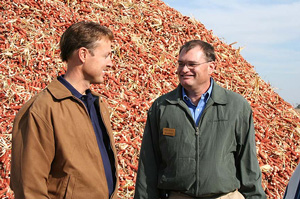 It took a lot longer than anticipated, but lawmakers in Wisconsin have finally reached agreement on that state’s budget… and the Wisconsin Biodiesel Association (WBA) says its $26 million renewable energy package will help make the state competitive in the biodiesel business.
It took a lot longer than anticipated, but lawmakers in Wisconsin have finally reached agreement on that state’s budget… and the Wisconsin Biodiesel Association (WBA) says its $26 million renewable energy package will help make the state competitive in the biodiesel business.
This story in Wisconsin Ag Connection says the WBA is applauding the approval of the biodiesel measures in the bill, including biodiesel distribution incentives, a $4 million grant to develop a soybean crushing facility, and a biodiesel producers’ state income tax credit:
“We are thrilled that the Legislature has made such a significant commitment to the biodiesel industry in Wisconsin,” said John Blaska, president of the Landmark Services Cooperative Board of Directors. “Thanks to the dedication of Governor Doyle and the efforts of State Sen. Jon Erpenbach, State Rep. Brett Davis, and State Sen. Bob Jauch, we are now one significant step closer to bringing Wisconsin’s first soybean crushing facility to Evansville.”
Landmark recently announced it will match any investment made by the state toward a soybean crushing facility in Evansville, up to $4 million. The addition of a soybean crushing plant will add substantial value to the state’s agricultural endeavors by cutting transportation costs and increasing soybean production, potentially bringing Wisconsin an additional $235 million in revenue and savings.
WSA Director Bob Karls says Wisconsin soybean farmers have been working for 15 years to bring a soybean processing facility to the state. While Wisconsin is the 13th largest soybean producer in the country, it is the only one of these states without its own soybean processing facility.
“It is difficult to envision a more concrete example of the way in which Governor Doyle’s pursuit of a renewable energy bio-industry could create more positive economic impact for the state,” said Jeff Pieterick, president of the Wisconsin Biodiesel Association. “The passage of this renewable energy package provides substantial infrastructure that supports the bottom line for agricultural producers throughout Wisconsin.”
 A Tennessee company will try to make biodiesel out of sludge from the Chattanooga public works and wood chips.
A Tennessee company will try to make biodiesel out of sludge from the Chattanooga public works and wood chips.

 Beavers spoke at the Conference on Clean Energy here on Monday where she outlined a number of initiatives that Google participates in aimed at reducing greenhouse gas emissions.
Beavers spoke at the Conference on Clean Energy here on Monday where she outlined a number of initiatives that Google participates in aimed at reducing greenhouse gas emissions. Ethanol producer
Ethanol producer  POET is harvesting, storing, transporting and performing research on 4,000 acres of corn in South Dakota this fall in order to find the most efficient way for farmers to harvest cobs in large quantities. At a media event this week, some of the equipment was put to the test. In the photo from Poet, a John Deere 9860 STS Combine harvests co-mingled corn grain and cobs and dumps them into a Kinze Auger Wagon on the family farm of Darrin Ihnen near Hurley, S.D.
POET is harvesting, storing, transporting and performing research on 4,000 acres of corn in South Dakota this fall in order to find the most efficient way for farmers to harvest cobs in large quantities. At a media event this week, some of the equipment was put to the test. In the photo from Poet, a John Deere 9860 STS Combine harvests co-mingled corn grain and cobs and dumps them into a Kinze Auger Wagon on the family farm of Darrin Ihnen near Hurley, S.D. 
 The famed ‘Crossroads of America’ could become the ‘Crossroads for American Energy’ if
The famed ‘Crossroads of America’ could become the ‘Crossroads for American Energy’ if 
 Ethanol production continued to grow in July, averaging 434,000 barrels per day according to the Energy Information Administration. Ethanol demand, as calculated by the
Ethanol production continued to grow in July, averaging 434,000 barrels per day according to the Energy Information Administration. Ethanol demand, as calculated by the  There’s been a lot of debate over the use of some foods as feedstocks for biofuels. But a company in Canada might have the solution that allows those feedstocks to be made into biodiesel, while retaining the proteins that are needed for animal feeds.
There’s been a lot of debate over the use of some foods as feedstocks for biofuels. But a company in Canada might have the solution that allows those feedstocks to be made into biodiesel, while retaining the proteins that are needed for animal feeds. It seems ethanol is on the lips of just about every politician both nationwide and at the state level. The fuel has broken into two major motorsports arenas. Environmentalists are touting ethanol as a major player in the development of renewable fuels. Much of the credit for the industrial, political and consumer awareness of ethanol belongs to the
It seems ethanol is on the lips of just about every politician both nationwide and at the state level. The fuel has broken into two major motorsports arenas. Environmentalists are touting ethanol as a major player in the development of renewable fuels. Much of the credit for the industrial, political and consumer awareness of ethanol belongs to the  It took a lot longer than anticipated, but lawmakers in Wisconsin have finally reached agreement on that state’s budget… and the Wisconsin Biodiesel Association (WBA) says its $26 million renewable energy package will help make the state competitive in the biodiesel business.
It took a lot longer than anticipated, but lawmakers in Wisconsin have finally reached agreement on that state’s budget… and the Wisconsin Biodiesel Association (WBA) says its $26 million renewable energy package will help make the state competitive in the biodiesel business.